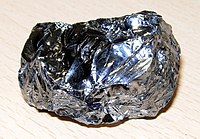
Photo from wikipedia
Abstract Spectral induced polarization (SIP) and bender element (BE) techniques show a high sensitivity to particle size, particle distribution and content of generated hydration products, which essentially govern the efficiency… Click to show full abstract
Abstract Spectral induced polarization (SIP) and bender element (BE) techniques show a high sensitivity to particle size, particle distribution and content of generated hydration products, which essentially govern the efficiency of ground improvement. In this context, both SIP and BE were integrated on a column setup to monitor the processes of lime and cement stabilization. A 5 mmol/L Na2CO3 solution was injected into the sand-lime mixture to produce CaCO3 precipitation, while deionized water was injected into the sand-cement mixture to induce the hydration of cement. The average diameters of the precipitated particles or clusters were calculated from the relaxation time, which was a significant parameter of SIP signals, via the Schwarz equation. Two pairs of BE were used to demonstrate the heterogeneity of the product precipitation, which was probably caused by the location of the inflow and outflow on the SIP-BE column. SIP and BE showed the capability of nondestructively monitoring the spatiotemporal chemical evolution processes, which could be helpful for engineering applications.
Journal Title: Journal of rock mechanics and geotechnical engineering
Year Published: 2020
Link to full text (if available)
Share on Social Media: Sign Up to like & get
recommendations!